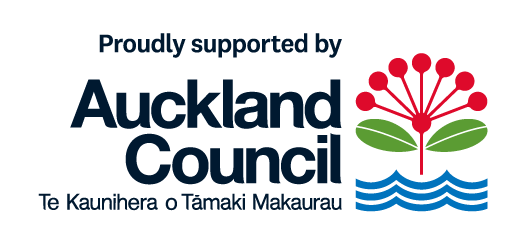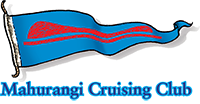‘Up the Mahu!’ day-after-the-regatta flotilla
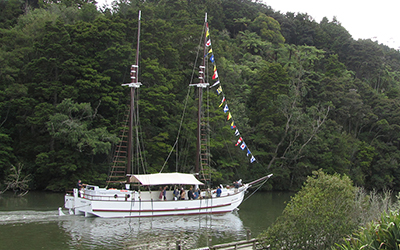
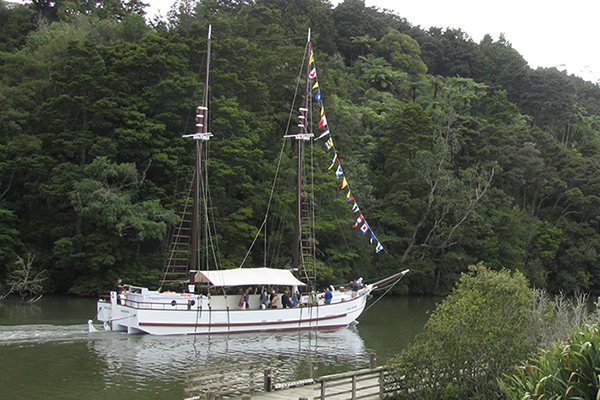
Down the Mahu: The Jane Gifford, in anything less than a gale, should be headed downriver daily from her traditional Mahurangi tidehead home port. Now, unless the dredging programme of the Mahurangi River Restoration Trust is promptly adequately funded, the scow will be forced to relocate to Auckland where she is not captive of the dramatic sedimentation that plagues the Mahurangi catchment. The Jane Gifford will depart Scotts Landing jetty at midday 27 January to lead the flotilla to Warkworth. image Mahurangi Matters
There could only be one flagship for the ‘Up the Mahu!’ day-after-the-regatta flotilla. She will lead the demonstration of support, departing the Scotts Landing jetty at midday.
The Jane Gifford scow, aside from being the face of the Mahurangi Regatta since 2010, following her heroic restoration, epitomises the necessity of dredging the Mahurangi River, even in the face of eventual multi-metre sea-level rise.
It is just one of the infinite ironies of anthropogenic global warming, or heating, as the phenomena was probably always better termed, that the attendant sea-level rise hasn’t begun to match the Mahurangi Harbour’s famously elevated sediment accumulation rate. Long after sea-level rise will have rendered many coastal settlements unviable, the sedimentation resulting from extreme rainfall events will be further choking upper estuaries with the all-too-thin topsoil that has survived colonial deforestation.
Peter Thompson, the powerhouse behind the rebuilding of the Jane Gifford, has, for 60 years, been aware of the inevitability of the Mahurangi River becoming unnavigable, privy to his father’s observation to a fellow river champion. Those privileged to read Claude Thompson’s account, written at the urging of his close friend Rex FairburnArthur Rex Dugard ‘Rex’ ‘ARD’ Fairburn, of his determined survival as a war slave and malaria victim, manually building a jungle railway, will see strong hints of the singlemindedness of the son. Just one detail of Claude’s account speaks volumes:
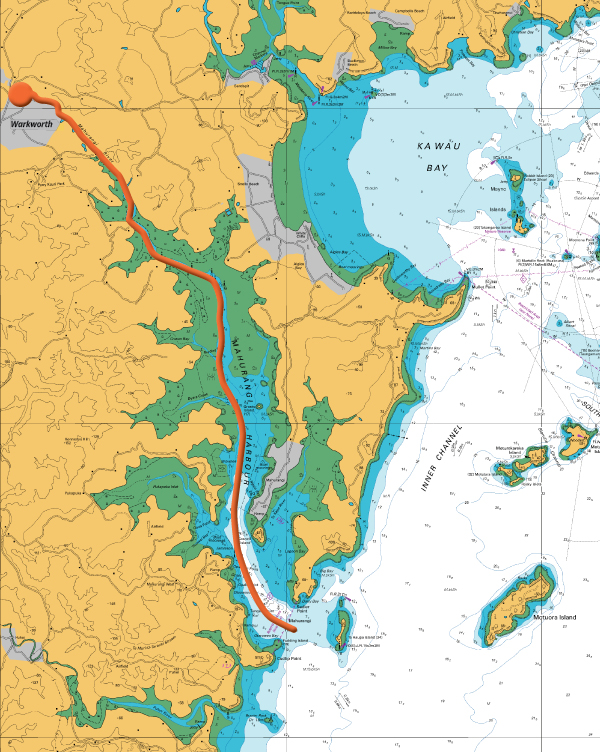
Fifteen-k Hikoi: Three hundred craft spaced at 50 metres would extend the 15 kilometres from the heads of the Mahurangi Harbour to its tidehead at Warkworth. A big ask of regatta goers to be sure, but in the context of the Sumatra Railway, which cost close to a life every two metres… chart Land Information New Zealand
The better you became at spiking, the less effort it took to drive a spike home. That meant a lot, for spiking you only had a certain number to do on each rail and then you could wait quite safely till the next rail came down … I realised that this should make my chances of living greater.
Had Claude succumbed to defeatism, and not escaped the work of the chronically diseased and emaciated gangs buckling under the weight of 10-metre lengths of rail, it is all but certain he would have counted amongst the more than 100 000—about 83%—of slaves dying building the 220-kilometre Pekanbaru Death Railway.
The saga of the saving of the Jane Gifford, and of amassing the infrastructure necessary to dredge the Warkworth town basin and Mahurangi River at a remotely affordable cost, would warmly warrant a full-length book. But for the story to enjoy a salubrious ending, Aucklanders need to recognise that without rallying to support this project in its hour of need, 20 years of planning and 10 years of concerted effort by the son of Claude Thompson could be wasted within sight of the finish line. Peter has pushed himself to the limits his health and financial resources to ensure that that work proper can be done at the lowest practicable cost, but unless that work is funded, the equipment will be sold and put to work elsewhere in a trice, and the opportunity to restore the navigability of the Mahurangi River lost, realistically, this century.
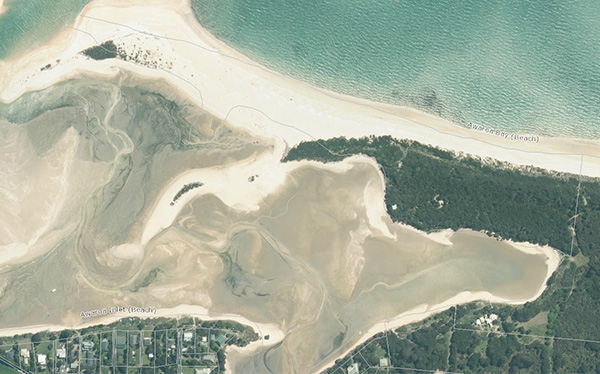
Awe Spit: The awfully inconvenient truth of multi-metre sea-level rise is that beaches such as that crowd-funded at Awaroa Spit will only be enjoyed by a further generation or two before being forever drowned—the ghostly property boundaries evident in this image providing clues as to the spit’s response to the as-yet modest, 150-millimetre sea-level rise that has occurred since industrialisation. But rather than be cause for defeatism, it is all the more reason to cherish and nourish coastal resources, which, in the case of the Mahurangi Harbour, means recruiting support to restore the forest cover that, until colonisation, kept the soil where it belongs, on the hillsides, rather than choking the Mahurangi River. map Top of the South Maps
Properly, most would say, a project that enjoys such solid community support should simply be state-funded. If the Mahurangi River was unambiguously provincial and not part of the Auckland region, the project would surely tick every box of the $1 billion Provincial Growth Fund, and may yet do, but while the Mahurangi is indubitably Tai Tokerau, nor is it Northland proper. With so much to play for, it would be prodigal to fail to use the opportunity of the Mahurangi Regatta to begin to build a launchpad for a concerted crowd-funding campaign. Hence ‘Up the Mahu!’, aimed at attracting every craft drawing less than a metre and a half. Dramatic drone footage of a procession of craft led upriver by the Jane Gifford, added to that taken during the regatta, should motivate even the most impervious mainstream-media news producer.
While it is not always obvious from the outside, crowd-funding campaigns such as the brilliantly successful 2015 ‘Buy this Beach’ that bought Awaroa Beach in 2016 belie an enormous behind-the-scenes effort. Adam Gard’ner and Duane Major were in war-room mode for a month before their passionate campaign to maintain public coastal access became that summer’s round-the-barbecue good-news story. They shared afterwards with the Mahurangi Coastal Trail Trust that they could have usefully used a year to better plan the initiative. But hard, round-the-clock work, and a number of lucky breaks, not least of which was Dr Gareth Morgan’s characteristically bumptious contribution, and the rest is now Abel Tasman National Park history. That the campaign became too popular for the government to ignore is instructive.
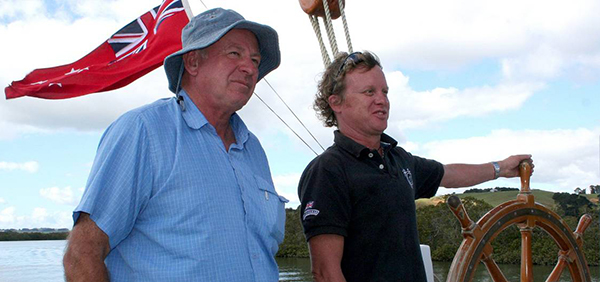
His Father’s Son of the Mahurangi: The devotion of Peter Thompson, left, to restoring the navigability of the Mahurangi River will never be matched or repeated. Personally pouring literally millions into putting the dredging infrastructure in place, Peter’s project is now at the mercy of the community, the council and the government to see through. And to put the Mahurangi dredging in perspective, consent has been given to remove a total of 120 000 cubic metres of the last 150 years’ accumulation, compared to the Ports of Auckland’s consent application for an ongoing 450 000 per year. And whereas sediment from Waitematā is egregiously fossil-fuel barged 150 kilometres to be dumped into the Pacific Ocean beyond Cuvier Island, the Mahurangi mud is painstakingly deposited adjacent the dredging site, usefully raising pasture that otherwise would been an early casualty of sea-level rise. image Stuff
To raise anything like the $2.8 million needed to buy Awaroa Beach for the far-less-sexy sell of town basin and river dredging is a huge, but far from impossible goal. The supporters, potentially, are two groups. The first, broad, group is all those who cherish the charm of Warkworth, and who stand to benefit from the tidehead town’s prosperity. The second group is much narrower, and the target of this article. It is the Auckland region’s boating fraternity, many of whom would make a trip up the sublimely scenic Mahurangi River an annual tradition, once the navigability of the river is restored and the town basin is adequately commodious. Unlike buying a beach, the benefits of restoring the navigability of the Mahurangi River will, for most, only be obvious after the event. But this is why leadership is indispensable. In an age of poll-driven politics, it is imperative that central- and local-government politicians stand up and fight for causes that might otherwise escape the attention of most voters. But equally, if the public fails to demonstrate real passion, the politicians could be excused for not sticking their necks out.
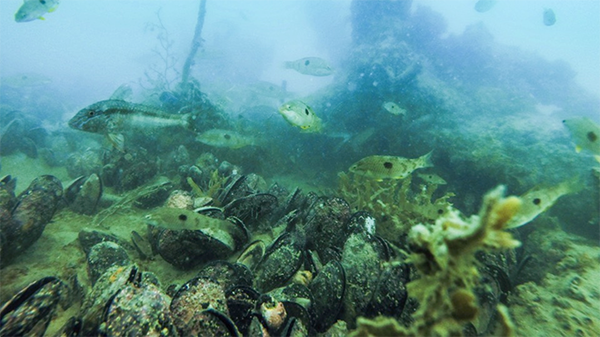
Supporter Friendly: Mahurangi Action is networking with other organisations in the Pūhoi to Te Arai space to make life for supporters easier, by, in addition to the unified and prioritised crowd-funding referred to here, building an affiliated membership tool that involves just one transaction a year, rather than multiple transactions for multiple memberships, which even the most enthusiastic of supporters can keep track of. This will mean that projects such as the magic Mahurangi green-lipped-mussel-reef-restoration research programme gets the support it so richly deserves, especially when it’s time get everybody aboard for those fleeting, once-in-a-lifetime opportunities. image Shaun Lee
Crowd-funding can be magnificent, or a deeply disappointing non-event. A Givealittle page set up for the Mahurangi River dredging was shut down four months later having collected only $1450 towards what was described as a $4 million project. Just one of the issues with the crowd-funding platform that started with so much promise is that fees are now charged. The 5% fees dissuade organisers from channelling their larger contributions through the site, leaving campaigns looking much more anaemic than they often are. What the Pūhoi to Te Arai needs is a crowd-funding tool branded for the community and only used for well-planned, prioritised campaigns. And, of course, fee-less; the exemplary nz$50 million per year Community Chest of Hong Kong made its reputation, from its establishment in 1968, on the fee-less model. Every cent donated is redistributed to the selected charities, thanks primarily to the support of the Hong Kong Jockey Club. Given the obscene overheads creamed from otherwise entirely worthy charities, New Zealand communities sorely need a similarly transparent institution.
The Mahurangi Regatta doesn’t ever ask for much from the region’s boat owners. But this year, it is asking all attendees to demonstrate their support for this do-or-die project. Yachts drawing too much to risk the shallows upstream will be urged to anchor line-astern from Mahurangi Heads to Motu Kaurias Grants Island deserves to be restored to, replacing its ill-suited stand of radiata pine that periodically peel off its perimeter, or as far up-harbour as their skippers feel confident. Provided that the wind is as light as it has been for recent regattas, by anchoring with a kedge from the stern, even those craft not actually underway upstream will, at least until the tide turns at 1.39 pm, appear to the drone to be part of the procession steaming upstream.
‘Up the Mahu!’ is the most natural, potentially pivotal crowd-funding pump-primer conceivable. Those who have the privilege of being aboard will know they helped make Mahurangi history.
Mahurangi Regatta supporters and collaborators
Auckland Council
Browns Bay Boating Club
Bucklands Beach Yacht Club
Classic Yacht Association
Corporate AV Services
Devonport Yacht Club
Ester Electrical – Scotts Landing prize-giving-and-dance lighting
Gulf Harbour Yacht Club
Mahurangi Action—principal organiser, revived regatta in 1977
Mahurangi Cruising Club—host club and sailing organiser
Mahurangi East Residents and Ratepayers Association—co-host of prize giving and dance
Mahurangi Oyster Farmers Association
Milford Cruising Club
Nautica Shipping & Logistics
New World Warkworth
Panmure Yacht and Boating Club
Pine Harbour Cruising Club
Prestige Loos
Richmond Yacht Club
Royal New Zealand Yacht Squadron
Sandspit Yacht Club
Teak Construction—principal regatta sponsor
Weiti Boating Club
West City Jazz Orchestra

